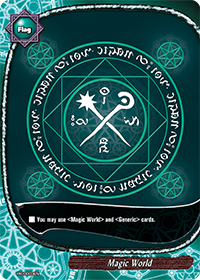 When it comes down to it, Magic World is set at the junction between math and strategy. You first have to build a deck that maximizes the potential of the variety of cards that Magic World offers. Magic World features the most impressive array of spells of any world currently and possibly to come. This means a ratio of monsters, items, and spells unlike any other. But once you have the deck down, there's still the actual part of playing the deck. This is where Magic World truly begins to shine.
When it comes down to it, Magic World is set at the junction between math and strategy. You first have to build a deck that maximizes the potential of the variety of cards that Magic World offers. Magic World features the most impressive array of spells of any world currently and possibly to come. This means a ratio of monsters, items, and spells unlike any other. But once you have the deck down, there's still the actual part of playing the deck. This is where Magic World truly begins to shine.Magic World can do anything. We're talking about everything between drawing tons of cards and gaining lots of resources to bouncing monsters back to hand and dealing direct damage. Most importantly, Magic World uses their effects not to win a confrontation but to bypass one entirely, resulting in an opponent who stares emptily as their winning image gets transformed into your winning image.
Whether you're backed by 72 Pillars of demons or Wizards of all kinds, Magic World is just a blast to play.
I'm going to put it straightly: this is not going to be a basic Magic World article. I mean, there's just too many spells and effects to deal with. For the sake of actually getting to the important points, I'm going to skip over certain cards. For example, I'm not going to talk about Nice One! Please, if you are not running 4 of this +0.5 advantage gainer in every Magic World deck then you might want to stop reading this article and read my card advantage article. Actually, you might want to review Algebra before then. Or maybe Pre-Algebra.
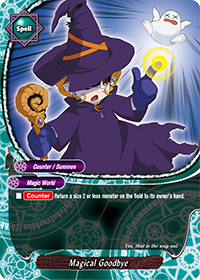 |
| TTYL |
Cards I won't cover include all Magic World weapons. Please, the math is simple and I've given ample and detailed examples all throughout my Math articles. Trans-flame has already been covered, and I shouldn't have to say why you should run always run Oops! (or at least side it or heavily consider it). Additionally, while having the options are good (I guess), math and common sense should show that Quick Summon, Holy Moly!, Bastin Caps, and Bye Bye Later! are not options you should be considering for the main deck, or even the side deck, really. The bottom line is that you just have to look at each card carefully and figure it out.
 |
| GTFO |
I will say, however, that Begone!! serves as an absolute Jackknife slayer. Whenever Jackknife tries to evolve, one cast of Begone!! will send both Jackknives to the drop. And they still have to pay the gauge. Sweet.
Also, totally irrelevant, but Begone!!'s official Japanese name is ゴー・トゥ・ヘル!!I just couldn't stop laughing.
 |
| Let the floodgates open |
Magic World decks can have a lot of spells. While every deck is different, I can say that you should have a minimum of 22 spells. The main reason I used this number is because it makes the worst-case probability for The Ark turn out really nice - 60%. At worst, you will have a 60% activation rate which, as usual, changes as you play, so keep track of the actual probability in your head. While set, The Ark can be bait for a lot of different destruction effects should your opponent run it. Additionally, since the effect is an [AUTO] timing and not a Counter, your opponent can actually use a spell negate on this card to kill you off for good. It's an interesting card to use, but practicality says that it's just too awkward for most Magic World decks.
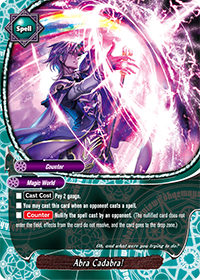 |
| Alakazam! |
Which is why this is one of the few worlds where I strongly suggest using the hand-to-gauge converter, Key of Solomon, First Volume. There are a variety of reasons why I will condone this card only in Magic World (future article!), but the basic principle is Magic World is one of the few worlds where gauge is dynamic and resource flows in both directions Magic World has plenty of cards that convert gauge into hand, which means that this card will never funnel resources to a "dead" sink. There will always be some immediate application and need for gauge.
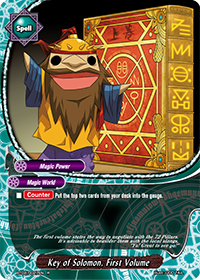 |
| "Local slang"? Who writes these things? |
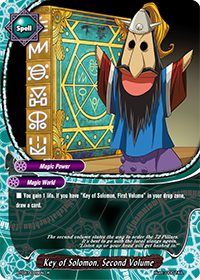 |
| Communicating with Demons, part 2 |
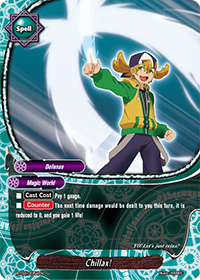 |
| Just take a chill pill |
When playing against Magic World, it's often very tempting to link attack the opponent directly. Don't. You'll do more consistent damage if you attack separately, even though it seems like they'll just Solomon Shield everything (they only have 4, remember). However, if there's any on-hit effect that you'd like to get through, feel free to link with the lowest crit card you have to force a Chillax! drop.
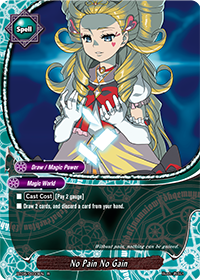 |
| Kinpatsu Rongu Ojou-sama chara |
People like Overstand! a lot because they see it and immediately think "better Key of Solomon". Not true. Overstand! can only be cast when you deal damage to your opponent, and Overstand! is only better than Key of Solomon if you deal more than 3 damage in one instance - something that Magic World doesn't do very often. Key of Solomon, being able to gauge ramp whenever you need it and also consistently generating 2 gauge is much better overall. Consistency over possible cheesy bonuses.
 |
| Yo wassup! Let's do this! |
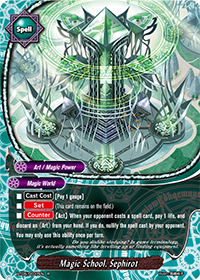 |
| School of Negates |
However, it's not as good as Abra Cadabra! Sephirot's problem is that in order to negate a spell you must first set the card (which can be destroyed) and then activate the effect, resulting in a combination far costlier than a single Abra Cadabra! to negate 1 spell. Even with 2 spells, Abra Cadabra! is cheaper. Sephirot must cancel 3 spells before it becomes cheaper to use than Abra Cadabra. The thing is, you don't really want to cancel 3 spells in a single game. Most matches can be won by canceling one crucial spell - it isn't something you aim to do every turn. And that's the second problem with Sephirot: you can only use it once per turn. So if your opponent stacks powerful spells back to back you can only at most negate one of them, and probably the first one. It's not flexible enough and there's a lot of counterplay that can be done. So while Sephirot is pretty great in transforming every Art card in your hand into cheaper Abra Cadabra, it's not that amazing in the whole scheme of things. Unless constant spell negating is the goal of your deck.
 |
| Don't lose determination! |
Never Say Never seems like a bad card at first, but then you realize the worst it can be is just normal timing +2 gauge and the best it can be is a huge life-saver. Also it's got Iris on the art. And a really bad Justin Bieber song as its name. Whatever. It's cute.
The best part about Gunrod Symphonion isn't the fact that it costs 1 life instead of 1 gauge. Nor is it the fact that it has 2 crit naturally, meaning that you can swing with it when you have an open center for more damage. Nor is it the fact that it can grab Great Spells from your drop zone with ease. But the fact that you can play it with all Magic World decks because they all use good Great Spell cards. In 72 Pillars, this grabs Saturday Night Devil Fever for those incredible OTK combos and in Wizards this is what guarantees extra turns with Grandfather Clock or a new lease at life with Auld Lang Syne. Actually, that's not true either. The best part by far is that this Gunrod can still rest to ping for 1.
- updated to H-BT03, CP01, H-EB02, H-TD02, PP01 -
All images used obtained from the official Bushiroad website and used here solely for reference purposes. Future Card Buddyfight!, logos, and respective content belong to Bushiroad. Large images belong to the Buddyfight! Wikia.

This comment has been removed by the author.
ReplyDeleteJust to be clear. When you are Gargantua'd while your life is less than four, does it go minus or just stop at zero?
ReplyDeleteIt goes to 0, but technically the value is at -1. Bushiroad is awkwardly picky about this point. You can never go below 0 health on paper, but all calculations will be done as if your health dropped below 0. The same goes for power/defense - you can never have negative, but calculations are done as if you did have negative.
Delete(sorry if double post but i don't find the previous one)
Deleteso you end up at one life point because reduce to 0 = nullify
right?
...what? What's the context of this question lol
DeleteWith the chillax vs gargantua punisher, the first part of the chillax (reduction of the damages) does not apply, but the second part (+1 life) does?
DeleteYes. You can survive Gargantua Punishers if, after all the calculations are over (including the negatives), you are left with 1 life.
DeleteIn other words, you can survive Gargantua Punisher with 4 life but not 3.
I'm afraid I don't understand the appeal of Oops. Yes, so-called "bounce" effects are handy to have, but is it really worth the two gauge, in a world that needs to make the absolute most of its gauge to succeed?
ReplyDeleteThe beauty of Oops! is the ability to bounce anything. You're not only allowed to bounce Size 3 monsters that Magical Goodbye cannot touch, but also items, set spells, etc. This gives a much greater freedom and ability to really destroy an opponent's strategy and guarantee a win. For instance, bouncing Glory Seeker before dealing game-winning damage so your opponent can't revive. Or bouncing Thunder Formation before the Final Phase so that your opponent won't be able to kill you that very turn.
DeleteIn addition, Magic World traditionally has issues with Size 3's, and Oops! gives great coverage in that regard. Also, with so much draw and search in Magic World, Oops! can be reliably teched in at 1 copy and still be accessible and useful.
Great article! I felt so smart when I first magical goodbye'd my asmodai to avoid my friend's 4 crit link attack. Key of Solomon is alot like forbolka in ancient where both worlds have alot of conversion cards so I feel like it's a must I still need 4 to try second volume with it.
ReplyDeleteChillax can be tough to fit in but I agree it stops people trying to play around solomon which has won me quite a few games. I play 72 pillars as you might know from the face book group so I'm looking forward to more from you.
Hi! Can you make an article about the wizards archetype? What are your thoughts about it?
ReplyDeleteMy thoughts are that I wish I have 48 hours in a day. Keep checking back, I'll get to them eventually.
DeleteI think Sephirot is best used during your turn as an offensive card, namely getting rid of a nullify which would otherwise save your opponent's monster from an attack. being limited to 1 counter per battle, 1 counter will definitely be enough for the job. sephirot is also support with gamigin and zaggan, you can also discard sephirot itself from your hand to meet the cost, another combo with gamigin. :)
ReplyDeletealso fills the dropzone to set up for saturday night
DeleteYeah, this is pretty much how you need to use Sephirot, so the minus doesn't matter much because you're closing out games quickly. Unfortunately, to efficiently do this, you need to run it in tandem with Great Barrier, which means...
Delete1) Devil Fever doesn't work because you won't have enough Size 1's.
2) The amount of field investment it forces you to put out means you're not going to have a good time if you don't close things out quickly.
I had to look up Power Ray Maximum because you didn't provide a name OR a picture. Either would be nice, yeah? Saves people work.
ReplyDeleteAnd now I want to play 72 Pillars.
Ctrl + F (Thunder Devastation)
Delete